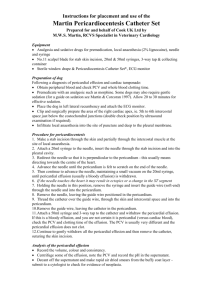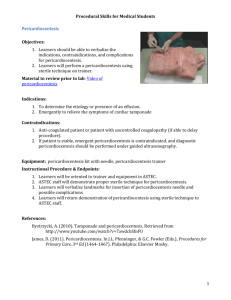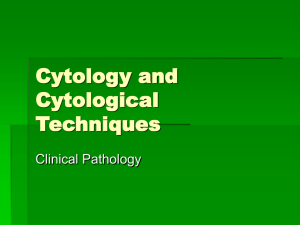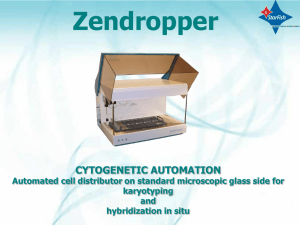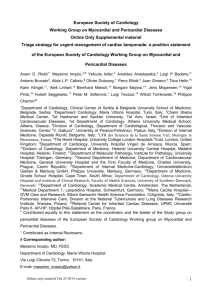Pericardiocentesis Guideline
advertisement
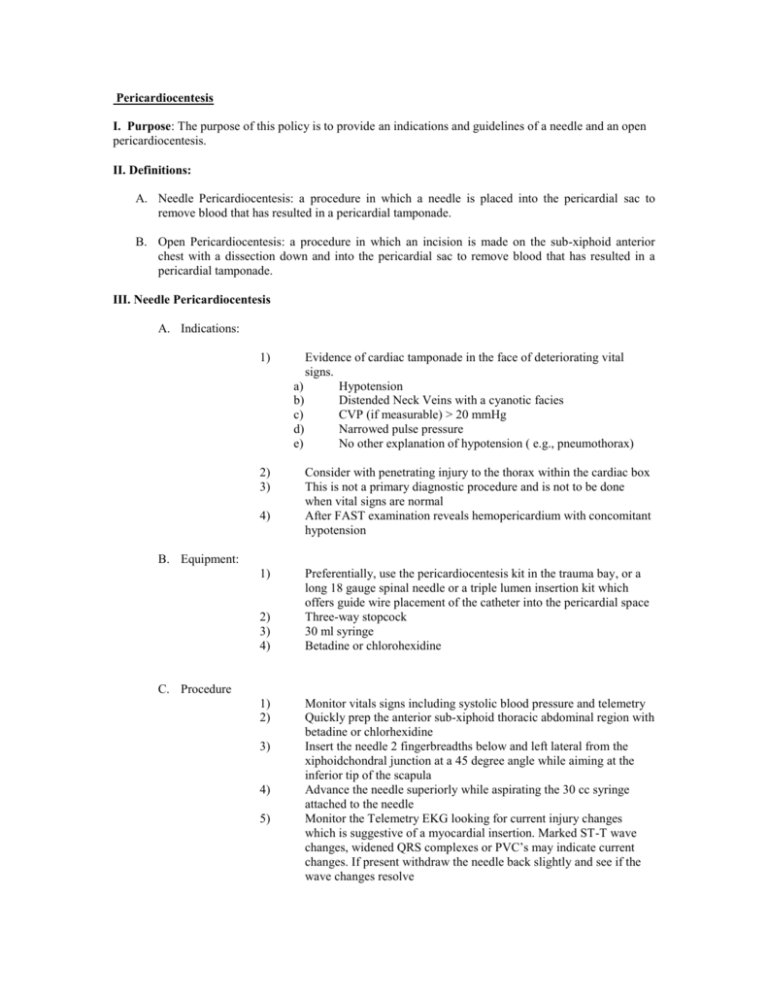
Pericardiocentesis I. Purpose: The purpose of this policy is to provide an indications and guidelines of a needle and an open pericardiocentesis. II. Definitions: A. Needle Pericardiocentesis: a procedure in which a needle is placed into the pericardial sac to remove blood that has resulted in a pericardial tamponade. B. Open Pericardiocentesis: a procedure in which an incision is made on the sub-xiphoid anterior chest with a dissection down and into the pericardial sac to remove blood that has resulted in a pericardial tamponade. III. Needle Pericardiocentesis A. Indications: 1) 2) 3) 4) Evidence of cardiac tamponade in the face of deteriorating vital signs. a) Hypotension b) Distended Neck Veins with a cyanotic facies c) CVP (if measurable) > 20 mmHg d) Narrowed pulse pressure e) No other explanation of hypotension ( e.g., pneumothorax) Consider with penetrating injury to the thorax within the cardiac box This is not a primary diagnostic procedure and is not to be done when vital signs are normal After FAST examination reveals hemopericardium with concomitant hypotension B. Equipment: 1) 2) 3) 4) Preferentially, use the pericardiocentesis kit in the trauma bay, or a long 18 gauge spinal needle or a triple lumen insertion kit which offers guide wire placement of the catheter into the pericardial space Three-way stopcock 30 ml syringe Betadine or chlorohexidine C. Procedure 1) 2) 3) 4) 5) Monitor vitals signs including systolic blood pressure and telemetry Quickly prep the anterior sub-xiphoid thoracic abdominal region with betadine or chlorhexidine Insert the needle 2 fingerbreadths below and left lateral from the xiphoidchondral junction at a 45 degree angle while aiming at the inferior tip of the scapula Advance the needle superiorly while aspirating the 30 cc syringe attached to the needle Monitor the Telemetry EKG looking for current injury changes which is suggestive of a myocardial insertion. Marked ST-T wave changes, widened QRS complexes or PVC’s may indicate current changes. If present withdraw the needle back slightly and see if the wave changes resolve 6) 7) 8) 9) Aspirate as much blood possible from the pericardial sac. If more than 50 cc of blood is removed from the pericardial sac without hemodynamic improvement, the needle may be in the left ventricle. If there has been hemodynamic improvement, leave the catheter in place and remove the needle. Place a 3-way stop cock on the end of the catheter followed by the syringe for repeated aspirations. Secure the catheter to the skin with suture. Notify the operating room immediately and transfer the patient to the trauma operating room (Room #1) for a median sternotomy versus a left anteriolateral thoracotomy. D. Complications: 1) 2) 3) 4) 5) 6) 7) Aspiration of ventricle blood rather than pericardial blood Laceration of the coronary artery or vein Laceration of the myocardium Laceration to the hilar vessels Hematoma Pneumothorax Infection III. Open Pericardiocentesis A. Indications: 1. Same as needle pericardiocentesis 2. Completed when needle decompression is either not decompressing the pericardium adequately or when the needle is being clogged off with pericardial clot 3. Consider under local anesthesia for known pericardial tamponade prior to intubation B. Equipment: 1. Diagnostic peritoneal lavage kit 2. Betadine or Chlorhexidine 3. Local anesthesia C. Procedure 1. Monitor vitals signs including systolic blood pressure and telemetry 2. Quickly prep the anterior sub-xiphiod thoracic abdominal region with betadine or chlorhexidine 3. Anesthetize the midline just below the xiphoid with local anesthesia 4. Make a 4 to 6 inch incision over the anterior aspect of the left lateral subxiphoid region 5. Carry the incision through the fascia and remain extraperitoneal 6. Retract the soft tissue up and superiorly 7. Bluntly dissect the diaphragm away from the sternum until the pericardium is in full view 8. Incise the pericardium to decompress the pericardial blood and clot. While incising the pericardium be careful not to lacerate the myocardium 9. If blood is evacuated from the pericardium then leave the wound open and notify the operating room immediately. Transfer the patient to the trauma operating room (Room #1) for a median sternotomy versus a left anteriolateral thoracotomy. 10. If blood or fluid is not obtained from the pericardium then close the fascia with non-absorbable suture and close the skin. D. Complications: 1. Laceration of the coronary artery or vein 2. Laceration of the myocardium 3. Hematoma 4. Pneumothorax 5. Infection/Cellulitis 6. Incisional hernia (delayed)
